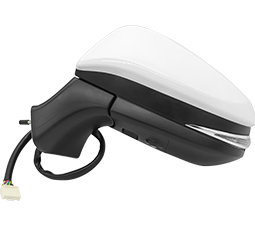2025-10-01
In today’s automotive market, technology is rapidly transforming even the smallest components of a car, and side mirrors are no exception. Once simple reflective surfaces to help drivers see behind and beside their vehicles, side mirrors now come with a range of advanced features such as automatic folding, heating, blind-spot detection, and integrated cameras. But the question remains: is an auto side mirror truly better than a traditional mirror? To answer this, it’s essential to examine the benefits, limitations, and real-world applications of both options.
1. Understanding Auto Side Mirrors and Traditional Mirrors
Traditional side mirrors are simple, manually adjustable mirrors attached to the exterior of a car. Their primary function is to provide a clear view of the lanes and traffic beside the vehicle. These mirrors are generally low-cost, durable, and easy to replace.
Auto side mirrors, on the other hand, incorporate technology to enhance safety and convenience. Common features include automatic folding when the car is parked, heating elements to prevent fogging or icing, power-adjustable angles controlled from inside the vehicle, and even integrated cameras that work with advanced driver-assistance systems (ADAS) to reduce blind spots. Some high-end models offer sensors that detect nearby objects or vehicles and alert the driver through visual or audio warnings.
2. Safety Advantages
One of the most significant advantages of auto side mirrors is improved safety. Many traditional mirrors have blind spots that can hide other vehicles or pedestrians, increasing the risk of collisions during lane changes or turns. Auto side mirrors with blind-spot monitoring or integrated cameras provide real-time alerts, helping drivers avoid accidents. Additionally, heated auto mirrors reduce fogging in cold or rainy conditions, ensuring the driver always has a clear view, which is especially valuable in regions with harsh weather.
3. Convenience and User Experience
Auto side mirrors also excel in terms of convenience. Power-adjustable mirrors allow drivers to fine-tune the mirror angle with the push of a button, eliminating the need for manual adjustments that can be cumbersome and time-consuming. Automatic folding mirrors protect the mirror housing in tight parking spaces or narrow streets, which is especially useful in urban areas. Traditional mirrors lack these conveniences, often requiring drivers to manually fold or adjust them, which may be inconvenient and sometimes unsafe if done while the vehicle is in motion.
4. Cost Considerations
While auto side mirrors provide numerous advantages, they come at a higher cost. The initial purchase price and potential repair expenses are typically higher than traditional mirrors. For instance, if an auto side mirror with integrated sensors or cameras is damaged in an accident, replacing it can be significantly more expensive than replacing a standard mirror. Drivers must weigh the benefits of enhanced safety and convenience against these potential costs.
5. Durability and Maintenance
Traditional mirrors are generally more durable due to their simpler construction. They are less likely to fail mechanically since there are no electronic components. Auto mirrors, however, include motors, heating elements, and sometimes cameras, all of which are susceptible to wear, electrical issues, or damage from extreme weather. Maintenance may require specialized service, adding complexity to routine car upkeep.
6. Future-Proofing and Technology Integration
One of the strongest arguments for auto side mirrors is their compatibility with modern vehicle technology. As cars move toward semi-autonomous or fully autonomous driving, traditional mirrors may become less effective. Auto mirrors, particularly those with cameras or sensors, can integrate directly with driver-assistance systems, adaptive cruise control, and lane-keeping technology. In this sense, auto mirrors offer a form of future-proofing, making them more suitable for modern and upcoming automotive innovations.
7. Conclusion
In conclusion, auto side mirrors provide significant benefits in terms of safety, convenience, and technological integration. They can reduce blind spots, improve visibility in adverse weather, and simplify mirror adjustments and parking. However, these advantages come at a higher cost and slightly increased maintenance requirements. Traditional mirrors remain a reliable, low-cost option, ideal for budget-conscious drivers or vehicles where advanced features are unnecessary.
Ultimately, whether an auto side mirror is better than a traditional mirror depends on a driver’s priorities. If safety, convenience, and integration with modern vehicle systems are important, auto mirrors are clearly superior. For those seeking simplicity, durability, and affordability, traditional mirrors still serve their purpose effectively.
